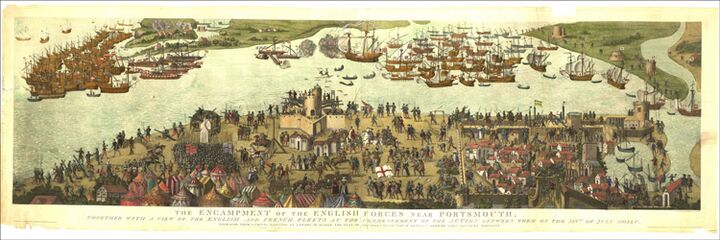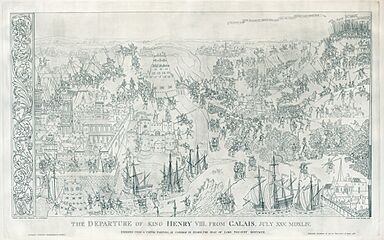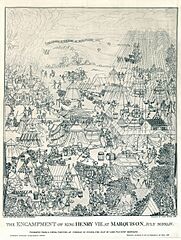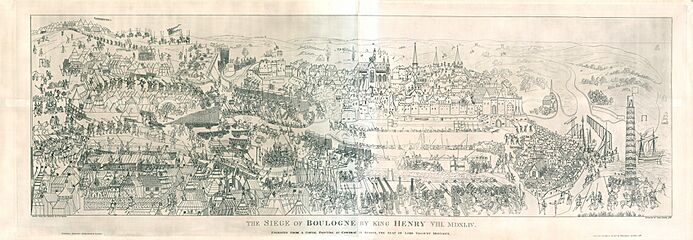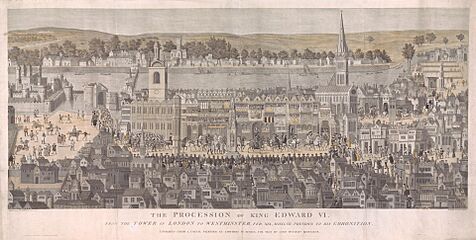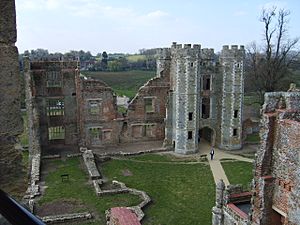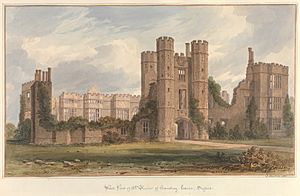Cowdray House facts for kids
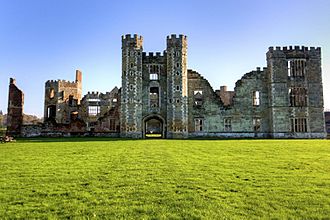
Cowdray Ruins
|
|
Quick facts for kids General information |
|
|---|---|
| Town or city | Midhurst, West Sussex |
| Country | England |
| Coordinates | 50°59′16″N 0°43′54″W / 50.9877°N 0.7317°W |
| Construction started | c. 1520 |
| Destroyed | 24 September 1793 |
| Owner | Viscount Cowdray |
Cowdray House is a famous old building in England. It is mostly ruins now, but it was once a grand Tudor house. It was similar in style to many large palaces and country homes of its time. Cowdray House is located in Easebourne, near Midhurst, West Sussex. It stands on the north bank of the River Rother.
A big fire largely destroyed the house on September 24, 1793. Even as ruins, it is very important historically. It is listed as a "Grade I" building. The house was also known for detailed paintings of events from the Tudor period. These paintings were destroyed in the fire, but copies of them exist from etchings made long ago.
Contents
The First Cowdray House
The very first house on this spot was a strong manor house. Sir John Bohun built it between 1273 and 1284. It was across the river from the town of Midhurst. He called it Coudreye. This was a Norman word for the hazel woods nearby.
Cowdray in the 1500s
In the 1520s, Sir David Owen started building the Cowdray House we see today. He was the uncle of King Henry VII. Sir David got the land after his wife, Mary Bohun, passed away in 1496.
In 1529, Sir David's son, Henry, sold Cowdray to Sir William Fitzwilliam. In 1533, Henry VIII allowed Fitzwilliam to create a large park. He also allowed him to build defenses at "Cowdry."
After the Dissolution of the Monasteries in 1536, Sir William received nearby church properties. His half-brother, Anthony Browne, later inherited Cowdray. It is said that a monk from Battle Abbey, who lost his home, put a curse on the family. The curse said, "by fire and water, thy line shall come to an end."
King Henry VIII visited Cowdray House five times. He came in August 1538, July 1539, and August 1545.
In November 1538, Margaret Pole, 8th Countess of Salisbury, was held at Cowdray. She was the last living member of the House of Plantagenet. She was a niece of Richard III, the last Plantagenet king. She was later moved to the Tower of London and passed away in May 1541.
In 1548, Sir Anthony Browne, son of the first Anthony Browne, inherited Cowdray. He later became the 1st Viscount Montague. This happened when Queen Mary I married King Philip II of Spain. Mary of Guise, the queen of Scotland, stayed at Cowdray in October 1551. Edward VI visited Cowdray in July 1552.
Elizabeth I visited Cowdray on August 14, 1591. She was greeted by a person in armor who offered her the keys. Later, actors performed for her in the gardens. They showed her an oak tree decorated with shields. They also performed a play by the fish ponds.
Henry Wriothesley, 3rd Earl of Southampton was born at Cowdray House. He was born on October 6, 1573. He was a courtier and supported writers. He is famous for being connected to William Shakespeare's poems and sonnets.
Cowdray's Famous Engravings
In the 1500s, Sir Anthony Browne ordered wall paintings for Cowdray House. These paintings showed important historical events. The original paintings were destroyed in the 1793 fire. However, copies of them were made as etchings before the fire. These etchings help us know what the paintings looked like.
-
The Siege of Boulogne by King Henry VIII in 1544.
Cowdray in the 1600s
In 1592, Anthony-Maria Browne inherited Cowdray. He was the grandson of the 1st Viscount. During his time, Guy Fawkes worked briefly at Cowdray House. The 2nd Viscount was even held for a short time. This was because he was thought to be involved in the Gunpowder plot. He had stayed away from Parliament on November 5, 1605, after a warning.
In the mid-1640s, Robert May, a famous cook, worked at Cowdray House.
During the English Civil War, the government took control of much of the Cowdray estate. This happened because Francis Browne, 3rd Viscount Montagu, supported the King. Soldiers from Parliament used the house as a base. You can still see marks on the walls of the main courtyard. These are thought to be from musketballs fired by soldiers.
Cowdray in the 1700s
In 1770, Anthony Browne, 7th Viscount Montagu, owned Cowdray. He hired Capability Brown to update the gardens.
On September 24, 1793, a terrible fire started. It happened during some repair work. Carpenters were working in the North Gallery. Some hot charcoal fell onto sawdust and wood shavings. The fire spread quickly. The family's furniture and treasures were also stored in that gallery. Only three paintings and a few small pieces of furniture were saved. Everything else, including items from Battle Abbey, was destroyed.
Less than three weeks later, George Browne, 8th Viscount Montagu, passed away. He was trying to ride over the Rhine Falls. The family title then went to a distant relative, Mark Browne. He later passed away without children, and the family title ended. These two events were seen as the end of the curse from 250 years earlier. The 8th Viscount's sister inherited the estate. Her husband was William Stephen Poyntz.
Cowdray in the 1800s and 1900s
In the early 1800s, the house was left to fall apart. Plants, especially ivy, grew all over it. This made it decay even faster. Some small changes were made to the Kitchen Tower, which survived. A floor was added above the kitchens, but no one lived there. After William Poyntz passed away, his three daughters inherited the estate. They could not agree on how to divide it. So, it was sold to George Perceval, 6th Earl of Egmont, in 1843.
In 1908, the 8th Earl of Egmont sold the estate. It was bought by Sir Weetman Dickinson Pearson. He became Baron Cowdray of Midhurst. Later, in 1917, he became the 1st Viscount Cowdray. The Viscount stopped the decay of the ruins. He had the ivy carefully removed. He also made sure any unsafe parts were repaired. A full study of the ruins was completed.
Cowdray Today
The house is still owned by the Viscount Cowdray. Currently, it is Michael Pearson, 4th Viscount Cowdray, who inherited it in 1995. A big project to preserve the ruins finished in 2006. The ruins were then opened to visitors on March 31, 2007. A charity called Cowdray Heritage Trust now looks after the ruins.
Cowdray House was an important setting in Anya Seton's 1972 historical romance novel, Green Darkness.
See also
- Cowdray Park, West Sussex, the nearby replacement house.



